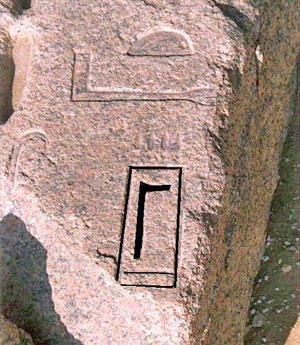|

by Stephen S. Mehler,
M.A.
from
GizaPyramid.com Website
We all recognize the word "Egypt" as the name of a
modern country in North Africa, not a part of the Middle East as is
commonly misperceived. Most Egyptologists and lay people know that
Egypt is derived from the Greek word
Aegyptos. But few have ever traced the origin of this word.
Aegyptos is a contraction of the Greek term
Hi-Gi-Ptos. Hi-Gi-Ptos was a Greek transliteration
of the ancient term Het-Ka-Ptah. Het
(Hit, Hat) meant "place," and Ka is a
term that has been subjected to many translations by Egyptologists.
We choose the indigenous definition, "the physical projection
of the soul"—not the body, which was Khat or
Khet but the personality that attaches itself to the
body. Ptah was the title of one of the so-called "Creator
Gods" or Neters. R.A. Schwaller de
Lubicz translated Neter to mean "principle or
an attribute of divinity, an aspect of God," not the whole
concept itself. The Greeks derived their word "nature" from
Neter, therefore receiving the teaching from the ancient
Egyptians of there not being a separation of nature and the divine.
So the term Het-Ka-Ptah meant the "Place of the
Projection of the Principle of Ptah" or the "Place
where the Projection of Ptah Manifested." This term is found
as an inscription on a stela near the modern Egyptian village of
Mit Rahaina situated near the ruins of the ancient
Egyptian capital city the Greeks named Memphis, known
to the ancients as Men-Nefer (The Generation of
Harmony).
Therefore, the term Het-Ka-Ptah referred only to one
site, one city that was the first capital of Dynastic Egypt,
not the whole country or civilization. The ancients referred
to their "country" as KMT, which has been
written many different ways: Kemet, Kemit, Khemet, Khem, Al
Khem—and the form we prefer, Khemit. It
literally meant "the Black Land" and referred to the
rich, black alluvial soil deposited by the Nile River, which allowed
the agricultural basis of the civilization to flourish. The
indigenous tradition of Egypt tells us the civilization was
Khemit, the people and language were called Khemitian.
Therefore, what I study and teach is Khemitology, not
Egyptology. This is a beginning paradigm for the presentation
of a whole new discipline, based on the teachings of indigenous
wisdom keepers, not Greco-Roman historians as espoused by academic
Egyptology.

by Stephen S. Mehler, M.A.
from
GizaPyramid.com Website
In a recent PAX Cable Television Network Special that
featured Christopher Dunn, the narrator stated that the
origin of the word "pyramid" was unknown. Both
academic Egyptologists and I would agree this statement is
incorrect, but I would strongly disagree with most Egyptologists
on the true origin of the word.
The word pyramid is derived from the Greek words
PYRAMIS and PYRAMIDOS. The meaning of
the word Pyramis is obscure and may relate to the
shape of a pyramid. The word Pyramidos has been
translated as "Fire In The Middle". This meaning is
very interesting and I will return to it later.
Well known American Egyptologist Mark Lehner has stated that
the ancient Khemitian term for pyramid was
something he calls MR.Pyramid. Lehner
bases this on his translation of MR as "Place of
Ascension" following his belief that pyramids were tombs
for kings and where the dead king’s souls "ascended". But
MR, usually written as Mer, is commonly
translated as beloved, as in Meriamen
(Beloved of Amen, The Hidden) or Meritaten (Beloved of
Aten, The Wiser). Our indigenous sources tell us Mer
meant "beloved" and had nothing to do with pyramid.
|
My Indigenous
Wisdom Keeper teacher, Abd’El Hakim Awyan, states
unequivocally that the ancient Khemitians used
the term PR.NTR, Per-Neter, for
pyramid. Per means "house"
and Neter we have discussed in the previous
article. Neter has been translated by
Egyptologists as "God" or "Goddess" but we
reject this mistranslation. In alignment with the indigenous
tradition, we use the interpretation "House of Nature,
House of Energy" for Per-Neter. The
temple was Per-Ba (House of the Soul) and the
tomb was Per-Ka (House of the Physical
Projection) according to the indigenous tradition.
With this
understanding of Per-Neter as House of
Nature, I state categorically that no one was
ever intended to be buried in a pyramid in its original
intent! Even Mark Lehner has admitted that no
evidence of an original burial in any of the major Khemitian
pyramids has ever been found. Also no inscriptions or
reliefs either depicting or stating that any king was ever
buried in a pyramid have ever been found.
One of the main purposes of the Great Per-Neter
was to generate, transform, and transmit energy. The
Indigenous Wisdom Keepers of Egypt have
provided us a concrete paradigm to support the power
plant theory of Christopher Dunn. Although
Egyptologists base their pyramid-as-tomb theories on the
writings of Greek historians such as Herodotus, the
Greek word Pyramidos is closer to the true meaning.
Indeed, if we support Dunn’s ideas that the
energy reactions in the Great Pyramid
took place in the so-called Queen’s and King’s Chambers,
then certainly it was Fire In The Middle. |

Glyph of Per-Neter,
House of Nature, Energy.
Taken by author at
Abusir,1997.
|
|